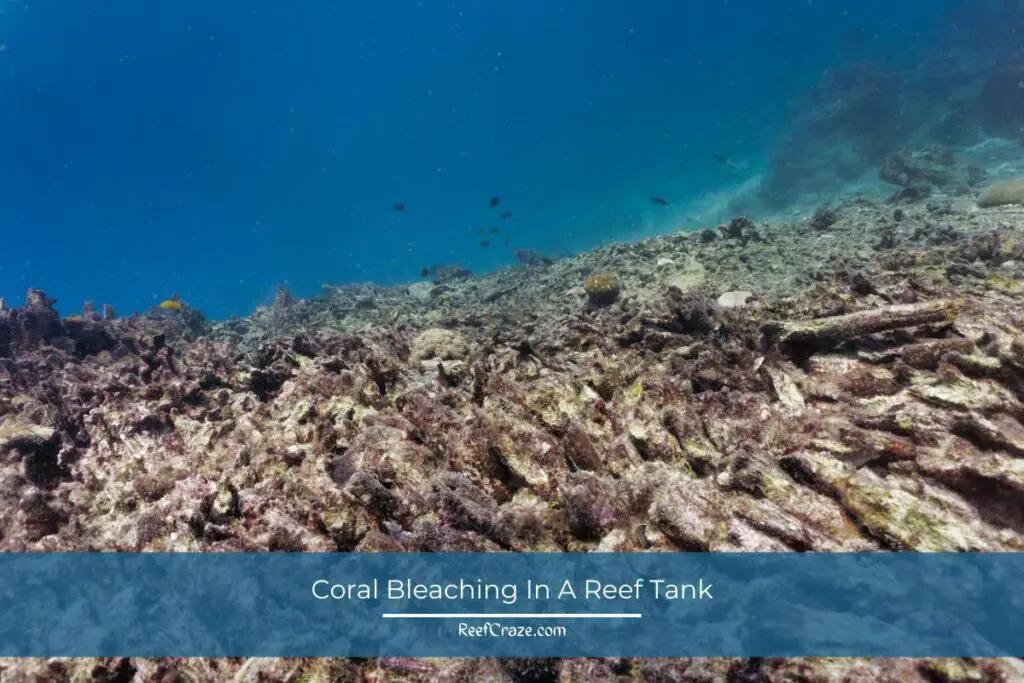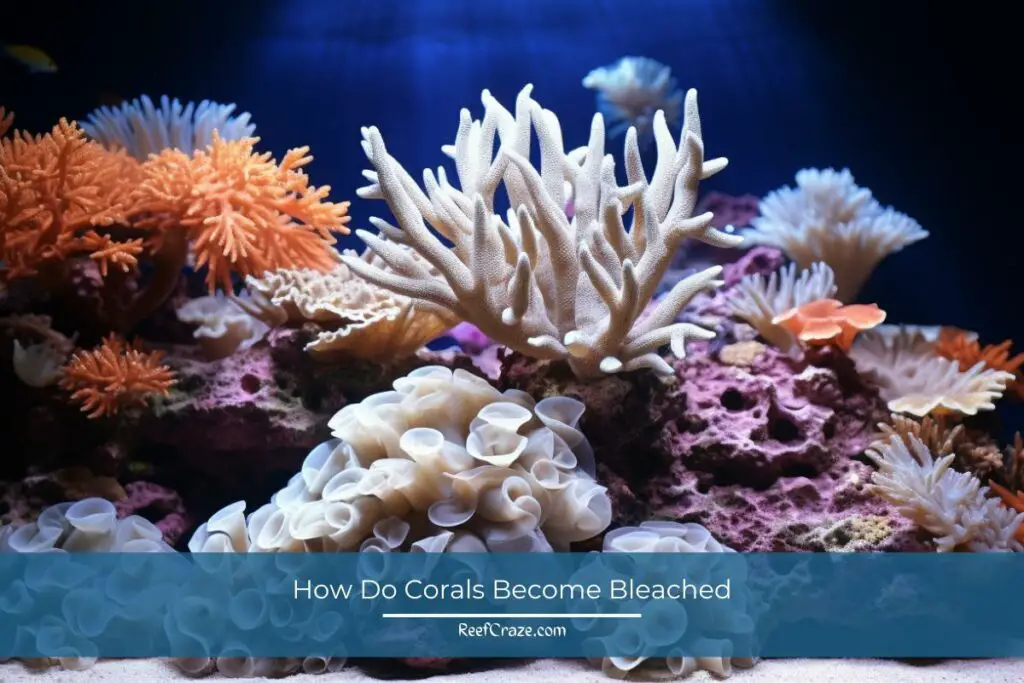Bleaching corals often cause reef tank owners to tear out their hairs in frustration. Even with a seemingly right setup and good water conditions, Corals can start to bleach out of nowhere. It’s a headache and a half for experienced tank owners and a nightmare for newcomers.
Coral bleaching is caused by the algae Zooxanthellae abandoning the tissues of the coral. It happens from stress-inducing events such as high temperatures, overexposure to light, overusing fertilizers, low pH or acidity, and the presence of heavy metals in your reef tank. Rapid fluctuation of environmental conditions in your reef tank can also cause corals to bleach.
There are also a few more subtle reasons why corals can become bleached. I’ve provided a detailed description of coral bleaching, its causes, and how you cure it in this article. I’ll conclude by telling you how to check off variables and identify the cause in case of coral bleaching.

How Do Corals Become Bleached?
Corals gain their food from a symbiotic relationship with the algae Zooxanthellae. These algae live within the corals’ tissues and supply the corals with sugar through photosynthesis. In exchange, the algae are provided a haven to reside in. This symbiosis has continued for millennia, and corals have become dependent on the algae for nearly 90% of their food intake.
When the symbiosis comes under threat due to stressful environmental conditions, the algae are unable to stay. Conditions such as high temperatures render the algae unable to produce sufficient food, and they abandon the corals. Without the algae, the corals can only produce 10% of the food they need.
Deprived of their major source of food, the corals lose their color and become bleached. If optimal conditions are restored within a short period, then Zoonxanthellae returns to inhabit the corals’ tissues once more, and the corals gain their colors back. However, if the corals are under duress for longer than 8 weeks, then they die off.

What Causes Coral Bleaching In Reef Tanks?
Coral bleaching is caused by any drastic changes made to the reef tank conditions, such as these.
1. High Temperature:
Any increase beyond 25-26° Celsius can cause Zooxanthellae to struggle with food production, even 1 degree above the optimal for 4 weeks. Converting CO2 to sugar through photosynthesis creates heat as a byproduct in algae, and high temperatures cause the efficiency and frequency of photosynthesis to drop. At intolerable temperatures, the algae can overheat and abandon the corals.
2. Cold Temperature:
Just as high temperature can hamper corals’ symbiosis and food production, cold temperature can damage these properties differently. In the short term, a cold climate will cause corals to bleach faster and have stunted growth. The cold will disrupt photosynthesis by forcing the Zooxanthellae to shrivel up, and the corals will waste more energy trying to generate optimal heat. Wild corals can adapt to the cold over time, but the corals in your reef tank will not survive.
3. Overexposure To Light:
When exposed to too much sunlight or artificial light, free radicals or chemically reactive Oxygen atoms will form at higher levels in your corals. The atoms will have a high oxidizing capability, which damages the protein, DNA, and cellular structures of the corals. The Zooxanthellae living inside the coral tissues are no longer safe, and they leave or stop photosynthesis.
4. Light Depravation:
The absence of light robs the Zooxanthellae of a vital component of the photosynthesis process. The algae fail to produce enough or any sugar for the corals at all, and the corals suffer from starvation. This stress causes the algae to leave, and the coral bleaches as a result.
5. Overusing Fertilizers:
If you overuse fertilizers for growing aquatic plants, especially any containing Nitrogen, then it can cause bleaching. The presence of Nitrogen in your reef tank will increase its heat retention and raise the temperature. The Zooxanthellae will struggle with photosynthesis and eventually abandon the corals.
6. Low pH Levels:
Low pH or acidity in your reef tank water will cause the calcium present in your reef tank to disperse. High amounts of CO2 in your reef tank will produce Carbonic acid, which blocks any exchange of Hydrogen ions and lower pH. The acidic environment inhibits any production of Calcium Carbonate, which makes up the structure of hard corals. The deprivation makes your corals’ skeletons wither, and the algae disperse, causing bleaching.
7. Heavy Metals Ion:
Heavy metal ions such as Lead, Iron, and Copper can cause bleaching in your corals. Lead itself is highly poisonous and can easily kill off both the corals and any Zooxanthellae present in them. Copper and Iron ions bond with needed organic compounds, create inedible complex chains, and reduce bioavailability in your reef tank. Copper can also create Hydroxyl radicals, which damage the protein, DNA, and structure of your corals through reduction reactions.
8. Rapid Fluctuations:
Frequent changes in water conditions make it harder for the corals to adapt. Many make this mistake when they prepare their reef tanks for a new climate and rapidly increase or decrease the temperature of the tank. Water changes can also throw off the equilibrium within your reef tank, and the corals have to struggle in adverse conditions. Changed pH, temperature, metals, and more will cause your corals to bleach.
9. Ozonation Of Tank Water:
Injecting too much Ozone for too long can cause high oxidation in your corals, eating away at their structures. Exceeding 400mV of ORP or 0.6 mg per hour per gallon or injecting 30 ppm rapidly will cause your corals and algae both to oxidate and die off, resulting in bleaching.
10. Air Exposure:
If your corals are exposed to air bubbles due to filtration or Oxygen injection, it can cause them to bleach due to stress. Air exposure causes a drying effect on your corals and causes disturbance within their structures. The algae cannot produce sugar due to the turbulence and leave.
There can be other causes for bleaching as well, such as a product that alters water conditions or switching your saltwater supply source. Cutting, damaging, or bruising the coral will also cause it to bleach. This is why fragging corals will cause them to bleach, but they’ll recover under optimal conditions.
How To Save Bleached Corals
If you have bleached coral in your reef tank, you still have 4-8 weeks before it completely dies off. Take advantage of this window to return your reef tank conditions to optimal, and the corals will gain back their color. Here are some things you can do to save bleached corals.
- Introduce biological filters such as rocks, sand and passive chemical filters such as GAC to remove toxins like Nitrates, Nitrites, and Phosphates.
- Switch to scheduled partial water changes instead of fully swapping out the water.
- Use a RO/DI filter to improve water conditions.
- If you’re using Ozone in your reef tank, consider pausing the treatment, or keep lowering the injection rate.
- Maintain a pH level between 8.1-8.3, and do not exceed 8.4.
- The alkalinity of your reef tank water should be above 125 ppm. The best range is 143-215 ppm.
- Calcium should be present within the 380-450 ppm range.
- Magnesium should be within the 1240-1350 ppm range.
- Limit Ammonium to less than 0.1 ppm and keep Nitrate under 1 ppm.
- Check your reef tank water for high Copper levels and any presence of Lead and eliminate it.
- Stop using fertilizers in your reef tank and find a safer brand to use in the future.
- Do not exceed or go under the 24-27° Celsius range. Keep the temperature at 25° Celsius for the best outcome.
- If you notice too much light or air bubbles around your corals, remove the sources immediately.
A combination of all these steps should restore your corals to their original healthy condition. If things still don’t improve, then check if you are using any additional supplements or products or if your reef tanks have any parasites. Bleaching will also make your coral vulnerable to diseases, so they may have contracted one while they were under stress. Thoroughly check for these issues and resolve them accordingly.
Conclusion
The best thing you can do if you see your corals bleaching is to not let the panic set in. Start by taking an exhaustive reading of your reef tank conditions, including temperature, pH levels, presence of CO2, toxins, heavy metal ions, and so on.
Observe which of these are outside the optimal parameters and fix them. And make sure to reach out to other reef tank owners on online forums with the details, as experienced owners can spot the issue and provide the proper solution right away.
